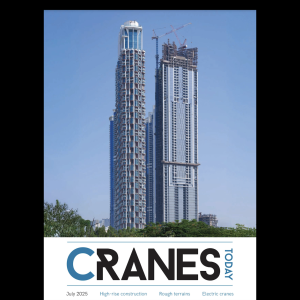Installing roof-mounted air handling units (AHUs) is an essential part of any commercial building construction. But UK lifting beam manufacturer Britlift believes that a key piece of equipment used to lift them into place often fall short of best practice – and in some cases could be breaking the law.
AHUs don’t always come with lifting points and cannot always be sling basketed. In the worst-case scenarios, installers are creating makeshift lifting points with steel bar or tube which is not fit for purpose.
“Crane lifting of AHUs is so commonplace that it’s easy to assume it’s done safely and to the letter of the law,” said Liam Botting, managing director at Britlift. “However, in Britlift’s experience, nothing could be further from the truth.
“Most companies want to be compliant and want to conduct lifting operations in the safest way possible. The decision-makers in these companies would be horrified if they knew sometimes random bits of bar are being used for lifting bulky, heavy AHUs to significant heights. If a lift goes wrong when you’re halfway up a skyscraper, the ensuing accident could be horrific.”
Even when AHU manufacturers specify a bar or tube size to be used for these lifts, the installer then has to procure it. However, most installers are unaware that these bars and tubes are classed as lifting equipment and therefore need the right certifications – without them, they are not legal.
“Most installers believe a test certificate – commonly called a LOLER cert – is all that is needed,” said Liam. “In fact, they need a DoC or EC Declaration of conformity, safe use instructions and the technical file to go with it, in compliance with LOLER and SOMSR regulations. The bar also needs the proper markings on it.”
In the UK, fixed points like lifting lugs are classed as part of the load and subject to less stringent requirements. However, separate pieces of lifting equipment such as underbeams, spindles or lifting bars are not classed as part of the load by law. This means they must comply with LOLER and SOMSR.
“Far too often, AHU installers are classifying these underbeams or lifting bars as part of the load when they absolutely are not,” said Liam. “They are detached from the load, reusable, and used time and again, for multiple lifts. This means by law they are regulated by LOLER and SOMSR and must be designed and manufactured in accordance with the appropriate standards.”
On top of this, installers procuring the bar or tube in this way are often unaware that they are legally liable for the lifting bar, rather than the AHU manufacturer even though the OEM specified it. The company employing the users of the equipment has the legal responsibility to ensure all lifting equipment conforms to legislation and is safe to use as per the LOLER regulations. It is the job of the responsible person on site to ensure that anything without the correct certification should not be used.
Britlift is calling on installers to use properly designed and certified lifting beams to ensure safe and compliant lifting.
“Britlift knows these lifts are an accident waiting to happen, as we often receive enquiries for spreader beams to be used in these operations above uncertified underbeams or similar,” said Liam. “It is usually a surprise to them when we start asking questions about what they’re using for lifting points.”






